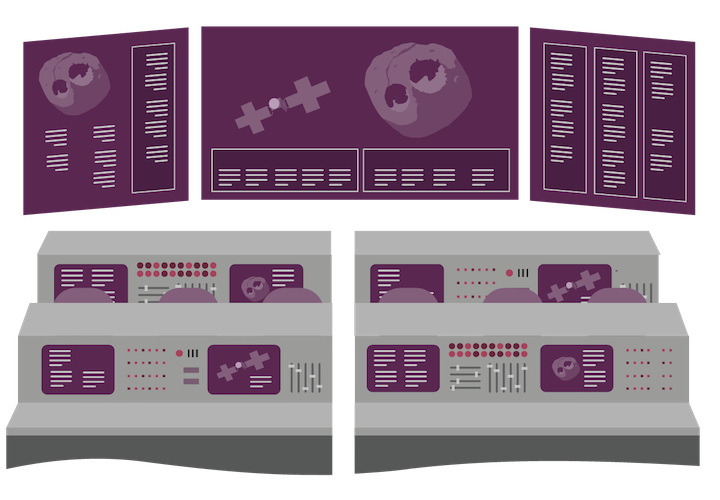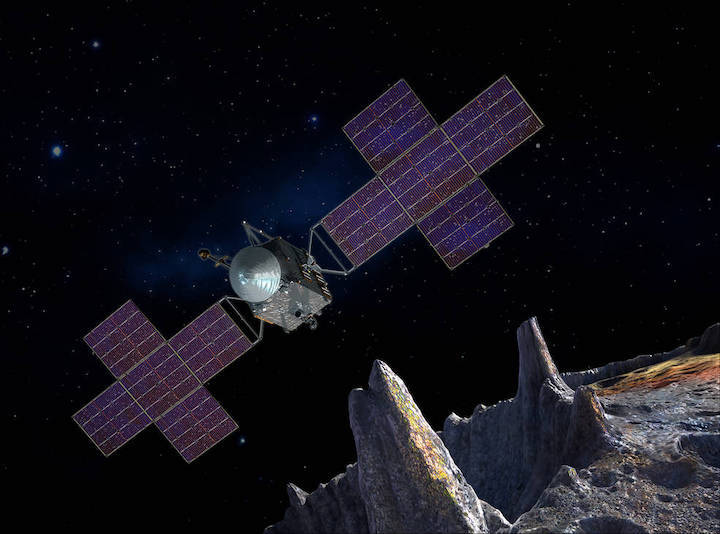20.04.2019
ASU-led NASA Psyche Mission to offer free online courses to learn about space exploration
The NASA Psyche Mission is a journey to a unique metal world called Psyche, an asteroid orbiting the sun between Mars and Jupiter. The mission is currently in development and the spacecraft will launch in 2022.
While instruments and components of the spacecraft are being designed and built across the country, the Psyche Mission management team, led by Arizona State University, is launching a series of free online courses called the NASA Psyche Mission Innovation Toolkit, based on the real-world challenges and skills associated with the Psyche mission’s science, engineering, technology, and teamwork.

Artist's rendition of a space mission control room, part of the materials included in the NASA Psyche Mission Innovation Toolkit. Image courtesy ASU EdPlus
“Our purpose in space exploration is to inspire and connect with all of humankind,” said Psyche mission principal investigator Lindy Elkins-Tanton of ASU’s School of Earth and Space Exploration. “The Psyche Mission Innovation Toolkit allows anyone in the world with internet access to learn the process, the words and the ideas behind a mission. We want to inspire everyone to imagine and plan how they are designing and running their own mission, whether it's to space, or a way to improve their community or drive their own vision."
The first course offering, "The Process and Lifetime of a Space Mission," gives students the opportunity to follow the creation of a NASA robotic space mission, from preparation and submission of a proposal, to team-building, design, construction, modeling, testing, launching, tracking and data collection and analysis.
“A space mission encompasses so much more than reaching a destination and sending back discoveries,” said Psyche mission co-investigator Cassie Bowman, who leads the mission’s online course program. “This first course being offered by the Psyche mission gives students the opportunity to learn about, and practice, elements of the process and lifetime of a space mission, from idea to flight.”
The course is divided into five modules that take approximately one hour to complete. During the course, enrolled learners can create their own online portfolio — called an "ePortfolio" — of their work and reflections. Participants who complete the course receive a downloadable and printable certificate of completion.
"The Process and Lifetime of a Space Mission" course is available to anyone online for free on ASU’s Continuing and Professional Education website. The only prerequisite is an interest in space exploration and the behind-the-scenes work that goes into planning and conducting a space mission. It is also recommended that participants have a persistent internet connection and the ability to read, write, and understand English or use a language translation program.
The Psyche mission team has plans to offer several more courses over the life of the mission and is currently working on a second course on this same platform, titled "The Inclusive Mindset: Tools for Building Positive Team Culture." The course is being developed in collaboration with Mansour Javidan, the Garvin Distinguished Professor of Management at ASU’s Thunderbird School of Global Management and director of the Najafi Global Mindset Institute.
This second course, which will be available later this year, will help learners understand the unique challenges and opportunities facing diverse teams; and to develop a set of skills to become more successful as leaders and team members.
“Every endeavor is a human endeavor and going to space is truly about the team,” Elkins-Tanton said. “So, for a successful mission, we want to build the very best teams and we are so fortunate to have one of the world's experts on teams, Mansour Javidan, help us design and build this course."
The Psyche mission
Psyche, an asteroid orbiting the sun between Mars and Jupiter, is made almost entirely of nickel-iron metal. As such, it offers a unique look into the violent collisions that created Earth and the terrestrial planets.
The Psyche spacecraft is planned to launch in August 2022 and travel to the asteroid using solar-electric (low thrust) propulsion. After flying by Mars in 2023 for a gravity assist, the spacecraft will arrive at Psyche in 2026 and spend 21 months orbiting the asteroid, mapping it and studying its properties.
The scientific goals of the Psyche mission are to understand the building blocks of planet formation and explore firsthand a wholly new and unexplored type of world. The mission team seeks to determine whether Psyche is the core of an early planet, how old it is, whether it formed in similar ways to the Earth's core, and what its surface is like.
The spacecraft's instrument payload will include a magnetometer, a multispectral imager, and a gamma ray and neutron spectrometer. The mission will also test a sophisticated new laser communications technology, called Deep Space Optical Communications.
The Psyche Mission is part of NASA's Discovery Program. Psyche Principal Investigator, Lindy Elkins-Tanton, is the director of ASU’s School of Earth and Space Exploration. Other ASU researchers on the Psyche mission team include Jim Bell (deputy principal investigator and co-investigator), David Williams (co-investigator), and Catherine Bowman (co-investigator and student collaborations lead).
The mission is led by Arizona State University. NASA’s Jet Propulsion Laboratory is responsible for the mission’s overall management, system engineering, integration and test, and mission operations. Maxar Space Solutions, formerly Space Systems Loral, is providing a high-power solar electric propulsion spacecraft chassis.
Quelle: New American University
----
Update: 29.02.2020
.
NASA has selected SpaceX of Hawthorne, California, to provide launch services for the agency’s Psyche mission. The Psyche mission currently is targeted to launch in July 2022 on a Falcon Heavy rocket from Launch Complex 39A at Cape Canaveral Air Force Station in Florida.
The total cost for NASA to launch Psyche and the secondary payloads is approximately $117 million, which includes the launch service and other mission related costs.
The Psyche mission will journey to a unique metal-rich asteroid, also named Psyche, which orbits the Sun between Mars and Jupiter. The asteroid is considered unique, as it appears to largely be made of the exposed nickel-iron core of an early planet – one of the building blocks of our solar system.
Deep within rocky, terrestrial planets, including Earth, scientists infer the presence of metallic cores, but these lie unreachably far below the planet’s rocky mantles and crusts. Because we cannot see or measure Earth’s core directly, the mission to Psyche offers a unique window into the violent history of collisions and accretion that created terrestrial planets.
The launch of Psyche will include two secondary payloads: Escape and Plasma Acceleration and Dynamics Explorers (EscaPADE), which will study the Martian atmosphere, and Janus, which will study binary asteroids.
NASA’s Launch Services Program at Kennedy Space Center in Florida will manage the SpaceX launch service. The mission is led by Arizona State University. NASA’s Jet Propulsion Laboratory is responsible for the mission’s overall management, system engineering, integration, testing and mission operations. Maxar Technologies is providing a high-power solar electric propulsion spacecraft chassis.
Quelle: NASA

